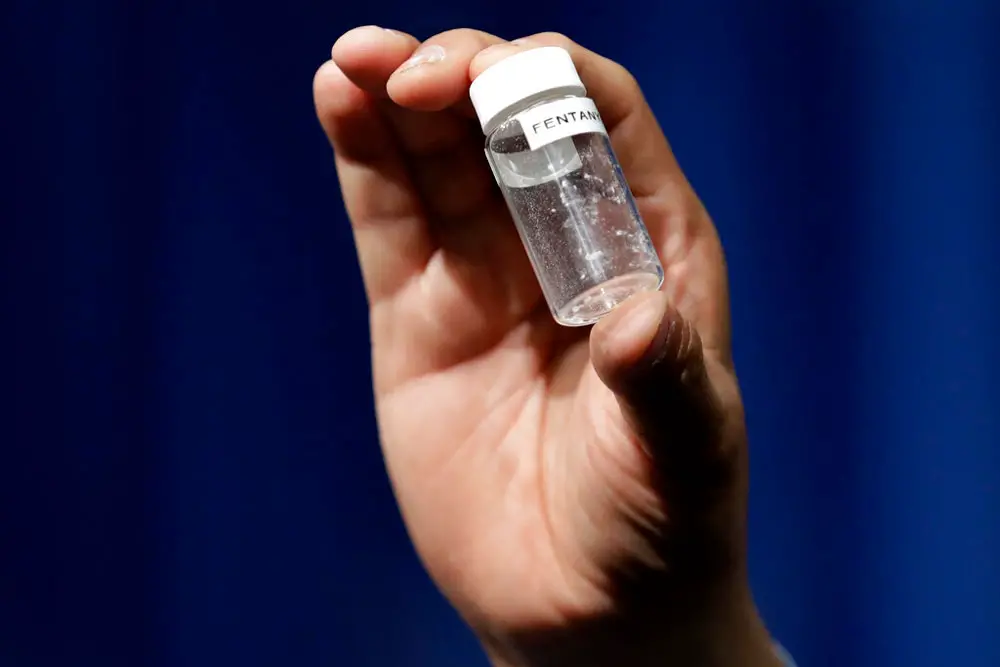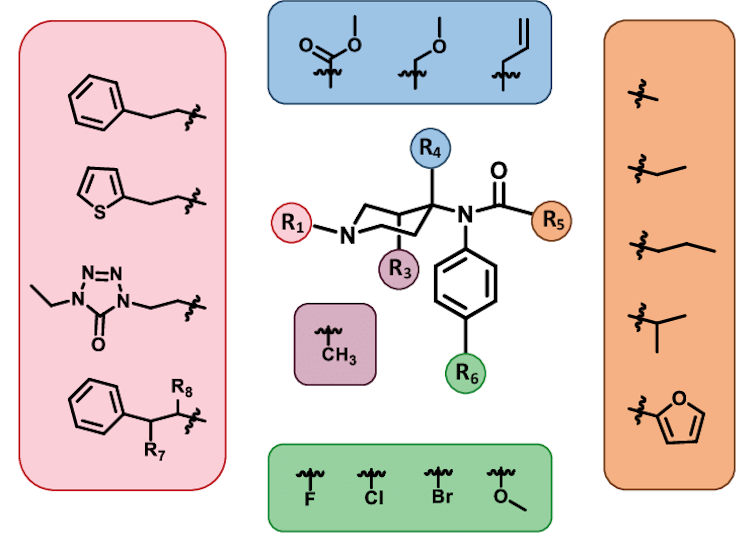
By Kavita Babu
Buying drugs on the street is a game of Russian roulette. From Xanax to cocaine, drugs or counterfeit pills purchased in nonmedical settings may contain life-threatening amounts of fentanyl.
Physicians like me have seen a rise in unintentional fentanyl use from people buying prescription opioids and other drugs laced, or adulterated, with fentanyl. Heroin users in my community in Massachusetts came to realize that fentanyl had entered the drug supply when overdose numbers exploded. In 2016, my colleagues and I found that patients who came to the emergency department reporting a heroin overdose often only had fentanyl present in their drug test results.
As the Chief of Medical Toxicology at UMass Chan Medical School, I have studied fentanyl and its analogs for years. As fentanyl has become ubiquitous across the U.S., it has transformed the illicit drug market and raised the risk of overdose.
Fentanyl and its analogs
Fentanyl is a synthetic opioid that was originally developed as an analgesic – or painkiller – for surgery. It has a specific chemical structure with multiple areas that can be modified, often illicitly, to form related compounds with marked differences in potency.

Christopher Ellis et al., CC BY-NC-ND
For example, carfentanil, a fentanyl analog formed by substituting one chemical group for another, is 100 times more potent than its parent structure. Another analog, acetylfentanyl, is approximately three times less potent than fentanyl, but has still led to clusters of overdoses in several states.
Despite the number and diversity of its analogs, fentanyl itself continues to dominate the illicit opioid supply. Milligram per milligram, fentanyl is roughly 50 times more potent than heroin and 100 times more potent than morphine.
Lacing or replacing drugs with fentanyl
Drug dealers have used fentanyl analogs as an adulterant in illicit drug supplies since 1979, with fentanyl-related overdoses clustered in individual cities.
The modern epidemic of fentanyl adulteration is far broader in its geographic distribution, production and number of deaths. Overdose deaths roughly quadrupled, going from 8,050 in 1999 to 33,091 in 2015. From May 2020 to April 2021, more than 100,000 Americans died from a drug overdose, with over 64% of these deaths due to synthetic opioids like fentanyl and its analogs.
Illicitly manufactured fentanyl is internationally synthesized in China, Mexico and India, then exported to the United States as powder or pressed pills. Additionally, the emergence of the dark web, an encrypted and anonymous corner of the internet that’s a haven for criminal activity, has facilitated the sale of fentanyl and other opioids shipped through traditional delivery services, including the U.S. Postal Service.
Fentanyl is both sold alone and often used as an adulterant because its high potency allows dealers to traffic smaller quantities but maintain the drug effects buyers expect. Manufacturers may also add bulking agents, like flour or baking soda, to fentanyl to increase supply without adding costs. As a result, it is much more profitable to cut a kilogram of fentanyl compared to a kilogram of heroin.
Unfortunately, fentanyl’s high potency also means that even just a small amount can prove deadly. If the end user isn’t aware that the drug they bought has been adulterated, this could easily lead to an overdose.
Preventing fentanyl deaths
As an emergency physician, I give fentanyl as an analgesic, or painkiller, to relieve severe pain in an acute care setting. My colleagues and I choose fentanyl when patients need immediate pain relief or sedation, such as anesthesia for surgery.
But even in the controlled conditions of a hospital, there is still a risk that using fentanyl can reduce breathing rates to dangerously low levels, the main cause of opioid overdose deaths. For those taking fentanyl in nonmedical settings, there is no medical team available to monitor someone’s breathing rate in real time to ensure their safety.
One measure to prevent fentanyl overdose is distributing naloxone to bystanders. Naloxone can reverse an overdose as it occurs by blocking the effects of opioids.
Another measure is increasing the availability of opioid agonists like methadone and buprenorphine that reduce opioid withdrawal symptoms and cravings, helping people stay in treatment and decrease illicit drug use. Despite the lifesaving track records of these medications, their availability is limited by restrictions on where and how they can be used and inadequate numbers of prescribers.
Other strategies to prevent overdose deaths include lowering the entry barrier to addiction treatment, fentanyl test strips, supervised consumption sites and even prescription diamorphine (heroin).
Despite the evidence supporting these measures, however, local politics and funding priorities often limit whether communities are able to give them a try. Bold strategies are needed to interrupt the ever-increasing number of fentanyl-related deaths.
![]()
Kavita Babu is Professor of Emergency Medicine, UMass Chan Medical School




























Jimbo99 says
One reason the police will never be defunded. If you’re a junkie addict, clean your life up and get off of this crap. The only one’s thinking they’re coming out ahead are the one’s manufacturing & dealing this crap. Don’t be weak and even try it. I will always support law enforcement & a justice system that prosecutes for OD deaths. That’s part of the costs of doing business with a Fentanyl or any other recreational drug dealer. These drugs have a medically necessity use only ? This is one crime that I’m all for the death penalty on. Someone dies from the toxic poison peddling, they need to strap that dealer into the chair and with a switch to the local FPL power station, flip the switch like you’re turning on the light in the bathroom for that session. Cheaper than year(s) of incarceration, nobody will miss the drug dealers & any other crimes they commit, the drive by shootings and whatever else.
Love thy neighbor says
Speaking in defense of the many Citizens of Palm Coast of Russian decent I have met over the last 20 years, I took offense to your title of Russian Roulette. The vast majority of Those with Russian Ancestry are hard working contributors to society and not aligned with Vladmir Putin and his insane quest to expand westward from his borders. Please be cognizant of these folks, They are good neighbors and do not wish to be associated with the actions of another. Thanks FlaglerLive, Keep up the good work.
FlaglerLive says
The headline refers to the author’s analogy in the first paragraph, with no connection, intended or otherwise, to current events in Ukraine.
Thanks says
Thank you for that clarification. Russian Roulette refers to inserting a live round into a revolver’s chamber, Spinning it and pointing said revolver at your head and pulling the trigger with 1/6 chance of death. Next round? 1/5 chance and so on. Popularized in American Hollywood movies, Nobody of Russian decent I ever met does anything like this. Keep it Real Sir!
The Geode says
Why don’t we just CANCEL every phrase, metaphor, analogy, expression, and idiom in the English language because no matter WHAT YOU SAY – somebody will go out of their way to find an offense
R. S. says
Time to legalize and control the distribution. Insanity is a matter of repeating the same procedures endlessly and expecting a different outcome.
Never Ending Story says
Street drugs likened to ‘Frankenstein opioids’ now surfacing in Ohio
A chilling bulletin dated April 20 from Ohio’s attorney general is laced with urgency about a new kind of synthetic street drug. It’s the kind of urgency echoed by Newtown Police Chief and opioid expert Tom Synan. If you are not getting your prescription medication from a doctor or a pharmacist, you are in danger,” Synan said recently.”
That danger could soon skyrocket, if a group of drugs known as nitazene compounds, hits southwest Ohio.
“It’s Iso, nitazenes — you ever heard of that?” WLWT investigative reporter Todd Dykes asked Casharay Pryor of Price Hill.
“I never even heard of that one,” Pryor said.
The drugs are so new, that most people Dykes talked to have no idea they exist.
“I have not heard of it,” Shiaire Dorsey of Westwood said.
That’s not the case among agents with Ohio’s Bureau of Criminal Investigation.
According to BCI, the state has seen 143 cases involving nitazenes so far this year. During the same time last year, there were only 27 cases. The spike represents an increase of 430 percent.
“It’s a synthetic opioid similar to that of fentanyl. So it’s much more potent than morphine and other drugs,” said Jason Schumacher, assistant special agent in charge of the DEA’s office in Cincinnati.
In his bulletin, Ohio Attorney General Dave Yost called nitazenes “Frankenstein opioids.”
He said, “Recent studies show nitazene compounds can be anywhere from 1.5 to 40 times more potent than fentanyl.”
oldtimer says
here’s a novel idea, don’t get involved with DRUGS